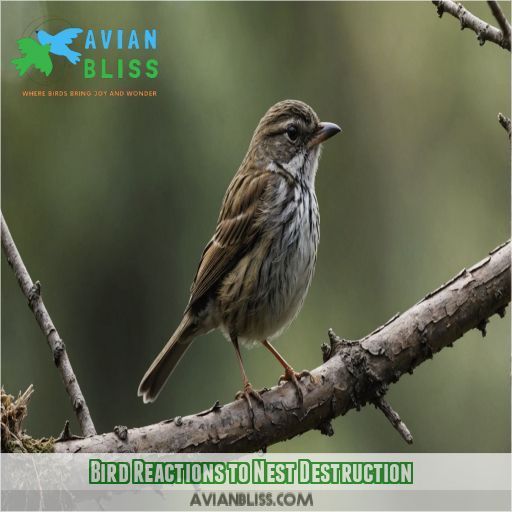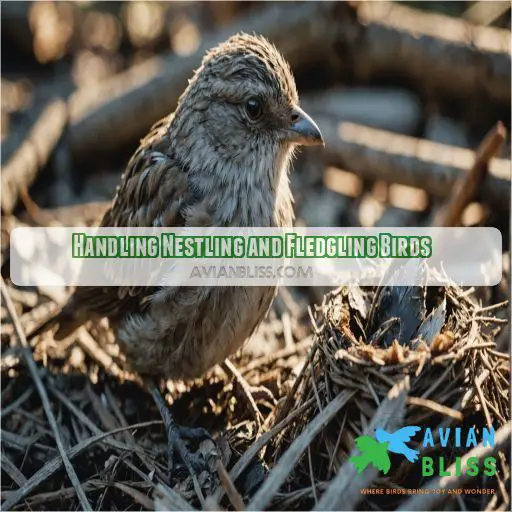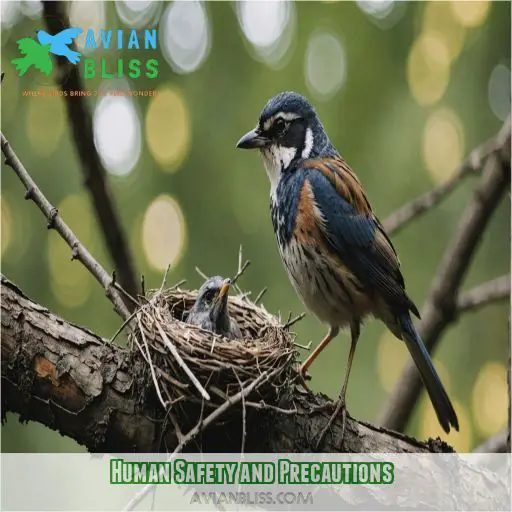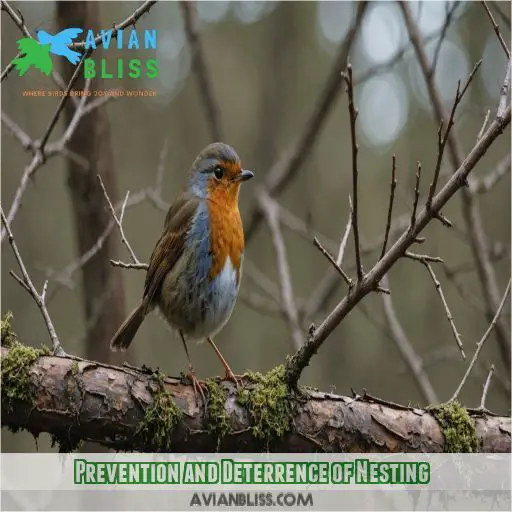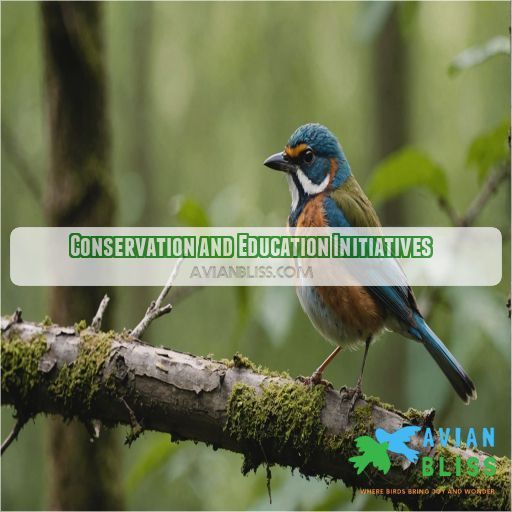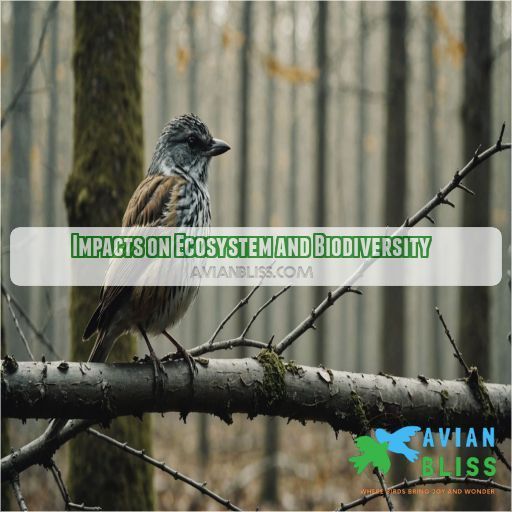This site is supported by our readers. We may earn a commission, at no cost to you, if you purchase through links.
 When birds face the unfortunate scenario of a destroyed nest, they’re like homeowners struck by sudden bad weather, shocked and in survival mode.
When birds face the unfortunate scenario of a destroyed nest, they’re like homeowners struck by sudden bad weather, shocked and in survival mode.
Birds typically scout for safer territories to rebuild and sometimes even return to repair damage the following season, especially if only part of their nest was wrecked.
Species like house sparrows show remarkable resilience, often improvising or moving swiftly to new locations.
This resilience is fascinating, reflecting nature’s "never give up" attitude.
But what birds do when their nest is destroyed doesn’t just affect them—it also holds implications for ecosystems and biodiversity.
Curious why? Let’s explore.
Table Of Contents
- Key Takeaways
- Bird Reactions to Nest Destruction
- Legal Implications of Nest Destruction
- Handling Nestling and Fledgling Birds
- Human Safety and Precautions
- Prevention and Deterrence of Nesting
- Conservation and Education Initiatives
- Impacts on Ecosystem and Biodiversity
- Frequently Asked Questions (FAQs)
- What if you destroy a birds nest?
- What to do with baby birds if nest is destroyed?
- Will a bird return to a disturbed nest?
- Is destroying a bird’s nest illegal?
- How do birds find new nesting locations?
- What materials do birds use for rebuilding nests?
- How does weather affect nest rebuilding process?
- Do birds ever share nests with other species?
- Can birds recycle old nesting materials?
- Conclusion
Key Takeaways
- When birds lose their homes due to a destroyed nest, they don’t just sit around moping. Instead, they’re like resilient architects – quickly assessing the damage and scouting new, safer locations for a rebuild. Think of them as tiny project managers managing a construction site, ensuring the well-being of their feathered family despite the setback.
- Destroying a bird’s nest doesn’t only upset the birds; it can cause a ripple effect across the entire ecosystem. Birds play vital roles, like spreading seeds and controlling pests. Losing them is like removing key players from a sports team, making the whole ecosystem feel off balance.
- You might think accidentally removing a nest is no big deal, but legally, it’s a feathered faux pas that can lead to hefty fines under protection laws like the migratory bird treaty act. It’s as if you’ve parked in a no-parking zone and everyone – feathered friends included – noticed!
- Handling baby birds after a nest destruction requires gentleness and care, especially during the fledgling stage
. Imagine them as precious cargo – they need safe and secure shipping back to a restored or temporary nest, where mom can return and continue their flight training with minimal stress.
Bird Reactions to Nest Destruction
When you accidentally disrupt a bird’s nest, you might find the feathered parents engaging in dramatic aerial displays or noisy protests akin to a neighborhood alarm system going haywire. This immediate avian pandemonium often masks the broader ecological impacts, leaving you pondering the long-term consequences for bird populations and the quirks of different species’ reactions.
Immediate Bird Behavior
Upon sudden nest removal, wild birds often react with distress calls. Imagine their surprise—like coming home to find your couch gone. Parental responses vary, but expect some defensive behavior. They’ll circle the area, trying to relocate nestlings and avoid predators. Different bird species show varying reactions, especially during nesting season. Yet, they’ll eventually focus on survival.
Long-term Effects on Bird Population
After birds scatter and regroup, the long-term effects of nest destruction unfold. Bird populations face a decline; it’s like a domino effect, triggering disruptions in community stability and breeding success due to habitat loss.
- Reduced breeding success affects overall population.
- Habitat loss leads to food scarcity.
- Community structure is shaken, like a tree losing branches.
Species-specific Reactions
Birds respond uniquely to nest destruction.
For example, house sparrows quickly adopt new nesting strategies, revealing impressive survival behaviors.
They engage in parental care, contemplating better nest site selection to rebuild nests swiftly.
However, don’t fret if bird droppings increase—it’s all in nature’s plan!
This emphasizes the principle of "tzaar baalei chayim," respecting every creature’s distress, akin to "shiluach haken.
Legal Implications of Nest Destruction
The destruction of bird nests can have serious legal consequences, as most are protected under the Migratory Bird Treaty Act (MBTA). Violating this law can result in hefty fines and even jail time, so it’s important to understand the legal framework surrounding nest management.
Migratory Bird Treaty Act (MBTA)
When birds face nest destruction, they’re not the only ones who react. The Migratory Bird Treaty Act (MBTA) steps in with serious consequences! Its history is rich, emphasizing safety for federally protected birds. But don’t fret! There are exceptions and precautions for bird nest removal. Just beware, those MBTA penalties could ruffle anyone’s feathers.
Bald and Golden Eagle Protection
Bald and golden eagles have nests guarded fiercely by the Bald and Golden Eagle Protection Act. Worrying about nest disturbance? Here are some insights:
- Obtain nest disturbance permits.
- Focus on habitat conservation.
- Engage in population monitoring.
- Support anti-poaching efforts.
- Conduct environmental impact assessments.
Just imagine: their nests are like the royal cribs of backyard birds, revered and indispensable.
Consequences for Illegal Nest Destruction
Imagine a bird coming home to find its nest gone. It’s not just a bad feather day; it’s illegal!
Destroying nests leads to legal penalties under the Migratory Bird Treaty Act, with fines looming like vultures overhead.
Embrace wildlife conservation by using bird houses and feeders instead.
Ethically, this reduces habitat disruption and aligns with nature’s "bal taschchit" – don’t waste!
Handling Nestling and Fledgling Birds
When you stumble upon a bird’s nest that’s been toppled, it’s like finding your umbrella inside out on a windy daychaos with a side of responsibility. Knowing whether you’re dealing with nestlings or fledglings is key because each requires different care, ensuring the birds hop back into their little lives without a hitch.
Identifying Nestlings Vs. Fledglings
Having navigated the legal maze of nest destruction, let’s get to know the little ones. Nestlings are like toddlers in Talmud Torah, sporting fluffy down and craving warmth. Fledglings, however, are adventurous teens testing new wings near bird baths. Spot the differences: nestlings rely on parents entirely, while fledglings show behavioral clues of readiness for flight.
Safe Return to Nest
Now that you’ve identified nestlings and fledglings, it’s time for parental retrieval behavior. Gently place nestlings back into their cozy nook with the care of a precious gem. Make sure momma bird finds everything just as she left it. Rescue operation techniques matter! Good intentions can sometimes lead to empty nestslike cake without frosting.
Temporary Nest Creation
After safely returning birds to their nest, sometimes a temporary nest might be needed. Locate durable materials like twigs or baskets. Placement is key; secure it where the original nest was, if possible. With careful monitoring, you’ll boost the success rate for chicks. Challenges? Keeping curious squirrels away! It’s like hosting a B&B without inviting the nosy neighbors.
Human Safety and Precautions
When handling bird nests, think of yourself as a cautious scientist suited up for an adventure—grab gloves and a mask to protect against germs and mites. Remember, it’s not a fashion statement, just a way to make sure you don’t bring home any unwanted nest souvenirs!
Proper Equipment for Nest Handling
When handling nests, remember safety’s your sidekick! You wouldn’t tackle a bees’ nest without armor, right? So, gloves and a mask are a must. Picture them as your superhero suit against dust and critters. Use sturdy tools to gently maneuver the nest into a container—your trusty sidekick’s hideout. This way, you’re safe while protecting nature’s fragile wonders.
Health Risks and Contaminants
Handling bird nests can put you face-to-face with unexpected tenants—let’s call them “critter condo residents.” Bird nest mites and bacteria can turn your day into a science experiment. To dodge these pathogens, wear gloves and masks as tick prevention superheroes would. Be the champion of parasite control, so the only hitchhikers you encounter are in storybooks!
Minimizing Disturbances During Removal
When removing bird nests, it’s important to minimize disturbances that could stress the birds. Time your actions carefully – wait for the adults to leave before taking down unoccupied nests. Avoid sudden movements or loud noises near active nests, and keep your distance to allow the parents to return and continue feeding their young. With a little patience and care, you can help birds through this sensitive time.
- Use soft, calm voices when working near nests
- Move slowly and avoid sudden motions
- Schedule nest removal for times when adults are away
- Maintain a safe distance from active nests
- Monitor nests discreetly to avoid disrupting feedings
Prevention and Deterrence of Nesting
If you don’t want birds nesting in certain areas of your home or property, try making these spots unattractive by removing enticing tree nesting materials and adding harmless deterrents like spikes or nets
. Regularly inspect your property for potential nest sites—think of it as the bird equivalent of checking under the bed for monsters, except the monsters are adorable feathered squatters.
Making Areas Unattractive for Nesting
To make areas unattractive for nesting, play “landlord” and implement habitat modification. Remove tempting food sources like seeds and waste, akin to locking the fridge from ravenous teenagers. Nesting site removal—primarily without evicting tenants—prevents returns. Add visual barriers, like a scarecrow at a bird wedding, to convince them the neighborhood’s gone downhill.
Using Deterrents
Deterrents like spikes, netting, or repellents can make your property less inviting for nesting birds. Just be sure to install them properly and check them regularly – you don’t want any critters getting hurt. With a little creativity, you can find humane ways to keep those feathered friends at bay without causing any harm.
Regular Property Inspection
While spikes and nets do the trick, regular property inspections are equally important. Keep your eyes peeled for nesting patterns and budding safety hazards. Conduct seasonal checks like you’re hunting Easter eggs. It’s like pest control, but friendlier. Make sure everything’s in legal compliance to keep birdsand, honestly, yourselfout of a pickle with the law.
Conservation and Education Initiatives
You can make a difference by joining conservation initiatives that protect bird habitats, often involving friendly nature walks or quirky local events. It’s like being a superhero for birds, just without the capeengage with community programs that teach you why our feathered friends are important to biodiversity!
Public Engagement in Nest Protection
When it comes to nest protection campaigns, getting involved can be as rewarding as a morning coffee! Join community outreach efforts and find volunteer opportunities that fit like a glove. Citizen science programs and educational initiatives make learning fun while boosting conservation. Remember, you’re not just helping birds; you’re building a vibrant community where everyone feels at home.
Awareness Programs and Community Involvement
Engaging the community is key to protecting bird nests. Local conservation groups host fun events like bird walks and nest-building workshops. Volunteer opportunities let you get hands-on with nest monitoring and habitat restoration. Educational programs teach kids about the importance of birds in our ecosystems. Get involved – your neighborhood will thank you!
Impacts on Ecosystem and Biodiversity
You might find it surprising, but when bird nests are destroyed, it can throw a wrench into the whole ecosystem. And let’s be honest, a few misguided feathers won’t be the only issue when these seasoned aerial architects disappear from their roles as pest controllers and plant propagators!
Role of Birds in Ecosystem Balance
Birds are like Nature’s multitaskers—they pollinate plants and keep pesky bugs in check, acting as environmentally-friendly exterminators. Through seed dispersal, they help forests flourish, ensuring food web stability. Think of them as guardians of biodiversity conservation, harmonizing ecosystems with finesse. Without them, you’d miss out on the vibrant tapestry they help weave across the earth.
Effects on Food Chain and Habitat
Birds keep the predator-prey balance in check and help with insect control, like tiny superheroes in feathered suits. They play big roles in seed dispersal, ensuring plant buddies pop up everywhere. But when their nests are disturbed, habitat fragmentation occurs. Over time, species diversity plummets like a deflated balloon, making everything feel a bit emptier and disconnected.
Importance of Biodiversity Preservation
When you protect bird nests, you’re doing your part to preserve the delicate balance of our ecosystems. Birds play a key role in maintaining biodiversity – from pollinating plants to controlling pests. By safeguarding their homes, you help make sure a thriving, interconnected world for all creatures great and small. It’s a win-win for nature and your community!
Frequently Asked Questions (FAQs)
What if you destroy a birds nest?
If you accidentally destroy a bird’s nest, you could face hefty fines. For example, one homeowner was fined $15,000 for removing a nest with baby birds. To avoid this, always check for nests before doing any outdoor work. It’s best to leave active nests alone.
What to do with baby birds if nest is destroyed?
If a nest is destroyed, gently return baby birds to the restored nest or a temporary one. Watch from a distance; mom might come back. Remember, those tiny chirpers are tough cookies learning to spread their wings!
Will a bird return to a disturbed nest?
When you disturb a bird’s nest, it’s like pulling the rug out from under them. Birds may see this as a threat and usually won’t return, opting instead for a fresh start elsewhere (Source).
Is destroying a bird’s nest illegal?
Destroying a bird’s nest can sometimes land you in hot water legally. Nests with eggs or chicks are off-limits under the Migratory Bird Treaty Act, and bald or golden eagle nests are always protected under federal law
How do birds find new nesting locations?
Imagine birds as house hunters—when an old nest is lost, they scout for new digs using instincts. They prefer places safe from predators, with abundant resources, much like you’d check for neighborhood safety and grocery stores.
What materials do birds use for rebuilding nests?
Birds, the ultimate recyclers, use various materials for nesting, including twigs, leaves, grass, feathers, and even human debris like string. These adaptable builders teach us that home is where you make it, despite setbacks.
How does weather affect nest rebuilding process?
When rebuilding nests, bad weather can really throw birds a curveball. Rain, wind, or extreme temperatures might slow them down, but like determined contractors, they often wait for calmer skies to gather materials and rebuild effectively (Source).
Do birds ever share nests with other species?
Ever seen a crowded dorm room? Some birds share nests with other species, forming unique "roommate" arrangements. It’s like a bird B&B, though not always by choice. Sharing helps with warmth and protection against predators.
Can birds recycle old nesting materials?
Birds can recycle old nesting materials like nature’s recyclers—House Crows and Baya Weavers, for instance, do this when nests are nearby, saving them the hassle of starting from scratch, making them true "upcyclers" of the bird world (Source).
Conclusion
A bird’s nest being destroyed is like watching a blockbuster drama unfold in nature.
Birds, with their impressive resilience, adapt and persist, teaching us about tenacity.
Understanding what birds do when their nest is destroyed not only fascinates birdwatchers but also informs conservation strategies.

